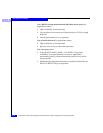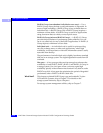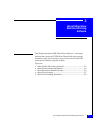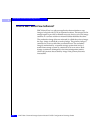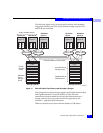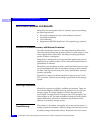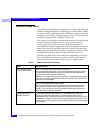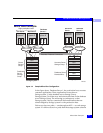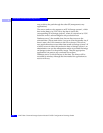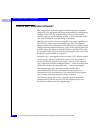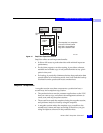
3
3-6
EMC Fibre Channel Storage System Model FC4700 Configuration Planning Guide
About MirrorView Remote Mirroring Software
Secondary Image Failure
A secondary image failure may bring the mirror below the minimum
number of images required; if so, this triggers a mirror failure. When
a primary cannot communicate with a secondary image, it marks the
secondary as unreachable and stops trying to write to it. However, the
secondary image remains a member of the mirror.
The primary also attempts to minimize the amount of work required
to synchronize the secondary after it recovers. It does this by
fracturing the mirror. This means that, while the secondary is
unreachable, the primary keeps track of all write requests so that only
those blocks that were modified need to be copied to the secondary
during recovery. When the secondary is repaired, the software writes
the modified blocks to it, and then starts mirrored writes to it.
The following table shows how MirrorView might help you recover
from system failure at the primary and secondary sites. It assumes
that the mirror is active and is in the in-sync or consistent state.
Table 3-1 MirrorView Recovery Scenarios
Event Result and recovery
Server or storage system
running primary image fails.
Option 1 - Catastrophic failure, repair is difficult or impossible.
The mirror goes to the attention state. If a host is attached to the secondary storage system,
the administrator promotes secondary image, and then takes other prearranged recovery
steps required for application startup on standby host.
Note: Any writes in progress when the primary image fails may not propagate to the secondary
image. Also, if the remote image was fractured at the time of the failure, any writes since the
fracture will not have propagated.
Option 2 -Non-catastrophic failure, repair is feasible.
The mirror goes to the attention state. The administrator has the problem fixed, and then
synchronizes the secondary image. The write intent log, if used, shortens the sync time
needed. If a write intent log is not used, or the secondary LUN was fractured at the time of
failure, then a full synchronization is necessary.
Storage system running
secondary image fails.
The mirror goes to attention state, rejecting I/O. The administrator has a choice: If the
secondary can easily be fixed (for example, if someone pulled out a cable), then the
administrator can have it fixed and let things resume. If the secondary can't easily be fixed, the
administrator can reduce the minimum number of secondary images required to let the mirror
become active. Later, the secondary can be fixed and the minimum number of required images
can be changed.



